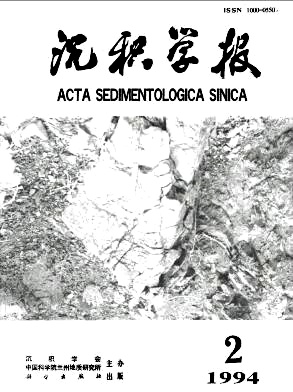The Autochthonous Storm Deposited Rudite Bodies of Wumishan Formation, Jixian System, Middle Proterozoic,The Ming Tombs District, Beijing,China
- Publish Date: 1994-06-10
Abstract: Abundant finely laminated algal stromatolitic dolomites occur in Wimishan Formation (Jixian System,Middle 1?roterozoic)of the Ming Tombs I?istrict,lieijing,China,which are formed in subtidal environments just above normal wave base. The finely laminated algal stromatolitic dolomites contain a lot of rudite bodies which are autochthonous storm deposits in origin. The characters of these sedimentary rudite bodies are as follows,(1)Rudites- a type of intraclasts-are same as host rocks (finely laminated stromatolitic dolomites) in composition. Each rudite is tens of cm in length and width, but is 1~2 cm or less in thickness, which can be also called flakstone, and has no rounding and little matrix. (2)Rudite bodies are lenticular shaped,thin out in three dimension space,and are 10~50 cm in thickness. ( 3 ) Rudites are radiating arranged or imbricated. (9)Abruptly or gradually contacted with host rocks latterally, sometimes both sides are gradual contacted,or both are abrupt, but sometimes one side gradual while another side abrupt contacted. These lenticular bodies are too small and too disorderly to proposed that they are formed by any normal currents,and can't be caused by normal waves, therefore, it would be formed by some suddenly, high-energy waves-i. e. storm waves. On the way to land,storm waves broken partly consolidated sediments on the floor during earlier stage of storm,then deposited the rudites (i. e. the broken sediments) into lenticular body in situ. After storm, finely laminated stromatolitic dolomites on the top of the autochthonous storm deposits by algae activity and carbonate pricipitation. The autochthonous storm deposits have a simple sequence which has only two zones-storm zone (S, radiating arranged or imbricated rudites, no rounding) and normal deposits zone(N, fine laminated stromatolitic dolomite sedimentation under fair weather).
| Citation: | Zhou Liqing, Shao Deyan. The Autochthonous Storm Deposited Rudite Bodies of Wumishan Formation, Jixian System, Middle Proterozoic,The Ming Tombs District, Beijing,China[J]. Acta Sedimentologica Sinica, 1994, 12(2): 72-76. |






 DownLoad:
DownLoad: